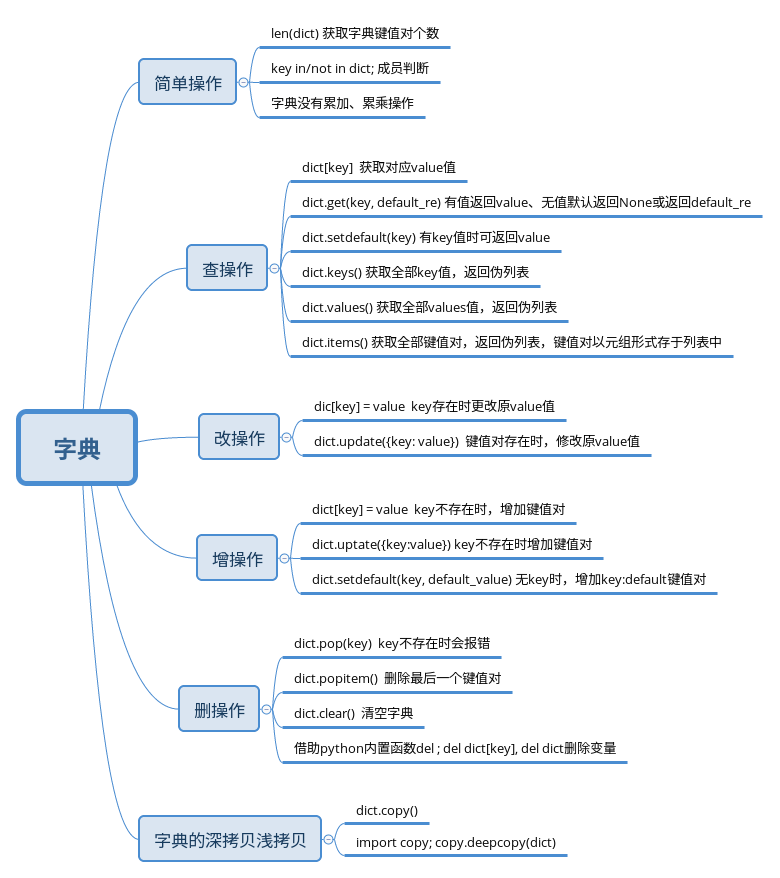1.通过key获取value
dict = {key1: value1, key2:value2}
dict[‘key1’] 可获取到key1对应的value1
person = {'name': 'tt', 'age': 13}
print(person['age']) # 13
test_dict = {'name': 'll', 'age': 90}
print(test_dict['height']) # 无value时程序报错,KeyError: 'height'通过dict[key] = value ,当key值存在是,会修改原value、当key值不存在时,会将key:value键值对添加到字典中;
person = {'name': 'tt', 'age': 13}
person['age'] = 24
print(person) # {'name': 'tt', 'age': 24}
person['height'] = 178
print(person) # {'name': 'tt', 'age': 24, 'height': 178}
2.字典的update()方法
dict.update(new_dict) 一次添加多个键值对,同样key值存在时更新key对应的value、key值不存在是添加key:value对;
person = {'name': 'tt', 'age': 13}
person.update({'like': 'football', 'age': 134})
print(person) # {'name': 'tt', 'age': 134, 'like': 'football'}
3.字典的setdefault()方法
dict.setdefault(key, default_value)
key值存在时,直接返回对应的value;key值不存在时,将key: default_value键值对添加进字典;
default_value值可省略,默认是None;
person = {'name': 'tt', 'age': 13}
print(person.setdefault('age', 45)) # 13
print(person.setdefault('like', 'football')) # football
print(person) # {'name': 'tt', 'age': 13, 'like': 'football'}
print(person.setdefault('height')) # None
print(person) # {'name': 'tt', 'age': 13, 'like': 'football', 'height': None}
4.获取字典全部值
dict.keys() 获取字典中全部key值,返回一个伪列表;
dict.values() 获取字典中全部value的值,返回一个伪列表;
dict.items() 获取字典所有的键值对, 返回伪列表,各键值对存在列表内的元组中;
person = {'name': 'tt', 'age': 13}
print(person.keys()) # dict_keys(['name', 'age'])
print(list(person.keys())) # ['name', 'age'] (可以转化成列表)
print(person.values()) # dict_values(['tt', 13])
print(list(person.values())) # ['tt', 13]
print(person.items()) # dict_items([('name', 'tt'), ('age', 13)])
print(list(person.items())) # [('name', 'tt'), ('age', 13)]
5.字典的get() 方法
dict.get(key) 获取对应value,无key时、默认返回None;
dict.get(key, default_value) 无key时,可以指定返回结果default_value;
person = {'name': 'tt', 'age': 13}
print(person.get('age')) # 13
print(person.get('like')) # None
print(person.get('like', 'no key')) # no key
print(person['like']) # 程序报错,KeyError: 'like'
# person['like']方式比get()方式可以节省部分时间,不用做key是否存在的判断(但基本可忽略不计)
# get()方式比person['like']方式,在返回结果上更友善些
6.字典的删除操作
dict.pop(key) 删除key:value对,并返回value值;key不存在时会报错;
dict.clear() 清空字典;
dict.popitem() 删除字典的最后一个键值对, 返回键值对存储在元组中;
同样可借助python内置函数del;
person = {'name': 'tt', 'age': 13, 'like': 'football', 'height': 168}
print(person.pop('name')) # tt (操作有返回值,值是value)
print(person) # {'age': 13, 'like': 'football', 'height': 168}
print(person.popitem()) # ('height', 168)
print(person) # {'age': 13, 'like': 'football'}
del person['like']
print(person) # {'age': 13}
# del person['name'] # KeyError: 'name' (无对应key时,会报错)
person.clear()
print(person) # {}
7.字典的copy()函数
复制字典内元素生成新字典;
# dict.copy() 依旧属于浅拷贝
person = {
'xiaoming': {
'age': 23,
'height': 178
},
'xiaohong': {
'age': 26,
'height': 168
}
}
new_person = person.copy()
new_person['xiaoming']['age'] = 999
print(new_person) # {'xiaoming': {'age': 999, 'height': 178}, 'xiaohong': {'age': 26, 'height': 168}}
print(person) # {'xiaoming': {'age': 999, 'height': 178}, 'xiaohong': {'age': 26, 'height': 168}}# import copy, copy.deepcopy() 可完成深拷贝操作
import copy
person = {
'xiaoming': {
'age': 23,
'height': 178
},
'xiaohong': {
'age': 26,
'height': 168
}
}
new_person = copy.deepcopy(person)
new_person['xiaoming']['age'] = 999
print(new_person) # {'xiaoming': {'age': 999, 'height': 178}, 'xiaohong': {'age': 26, 'height': 168}}
print(person) # {'xiaoming': {'age': 23, 'height': 178}, 'xiaohong': {'age': 26, 'height': 168}}
8.其它简单操作
in ,not in 成员判断;
len(dict) 判断字典长度;
test_dict = {'name': 'll', 'age': 90}
print('name' in test_dict) # True
print(len(test_dict)) # 2
# 字典没有累加累乘操作
总结

原文地址:http://www.cnblogs.com/white-list/p/16807777.html
